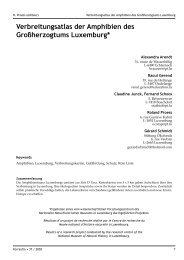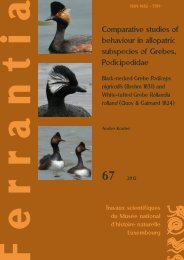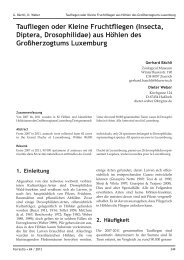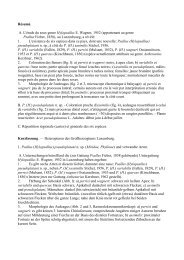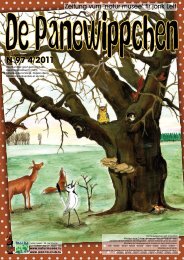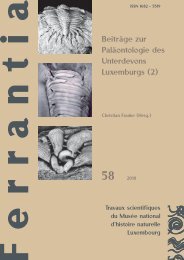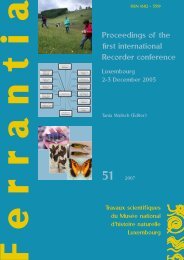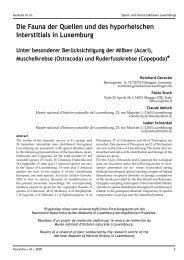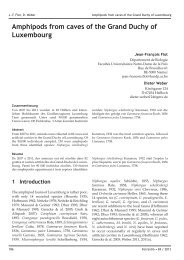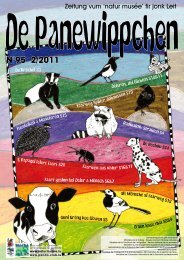Les bryophytes du Luxembourg - Musée national d'histoire naturelle
Les bryophytes du Luxembourg - Musée national d'histoire naturelle
Les bryophytes du Luxembourg - Musée national d'histoire naturelle
Create successful ePaper yourself
Turn your PDF publications into a flip-book with our unique Google optimized e-Paper software.
J. Werner <strong>Les</strong> <strong>bryophytes</strong> <strong>du</strong> <strong>Luxembourg</strong> - Liste annotée et atlas<br />
42<br />
MODELE EXPLICATIF<br />
ANNEXE 1: LISTE ANNOTEE DES BRYOPHYTES<br />
APPENDIX 1: ANNOTATED LIST OF BRYOPHYTES<br />
Numéro courant (sur cartes et listes)<br />
– (1) Binôme latin – Noms d'auteurs –<br />
(Premier récoltant), première publication (2) –<br />
District géographique (secteur) (3) – RARETE<br />
(4) – Ecologie (5) – (Publications ultérieures)<br />
(Remarques) (6) – Statut Liste Rouge (7)<br />
(1) La présence d'un astérisque (*) signale que ce taxon<br />
ne fait pas partie de la flore luxembourgeoise.<br />
(2) Le nom <strong>du</strong> bryologue qui a été le premier à<br />
récolter le taxon au <strong>Luxembourg</strong> est indiqué<br />
seulement s'il diffère <strong>du</strong> nom de l'auteur de la<br />
publication. – La première publication n'est<br />
indiquée que si elle est postérieure à 1985.<br />
Pour les autres taxons il est renvoyé à De<br />
Zuttere, Werner & Schumacker (1985).<br />
(3) OE = Oesling (district ardennais luxembourgeois);<br />
GU = Gutland (district lorrain luxembourgeois).<br />
– Secteurs: EM = vallées de l'Eisch et<br />
de la Mamer, MI = bassin minier (canton d'Eschsur-Alzette,<br />
calcaires ferrugineux), MO = sillon<br />
mosellan et Basse-Sûre, PS = Petite-Suisse; gr<br />
= régions gréseuses en général; HA = Haute-<br />
Ardenne; ! = uniquement dans ce secteur.<br />
(4) D'après le nombre de localités connues en<br />
réseau IFBL (4 x 4 km): RR (très rare) = 1 ou 2,<br />
R (rare) = 3 à 10, AR (assez rare) = 11 à 24, AF<br />
(assez fréquent) = 25 à 49, AC (assez commun)<br />
= 50 à 99, C (commun) = 100 à 149, CC (très<br />
commmun) = 150 à 200.<br />
(5) <strong>Les</strong> codes abrégés sont donnés au tableau 3;<br />
une écologie particulière est donnée éventuellement<br />
entre parenthèses.<br />
(6) <strong>Les</strong> publications ultérieures ne sont indiquées<br />
que pour les taxons rares ("Voir:") – "Remarques":<br />
par exemple mention des révisions effectuées,<br />
observations sur la difficulté <strong>du</strong> groupe,<br />
données incertaines etc..<br />
(7) Werner (2003b, 2008) – CR = critically endangered,<br />
DD = data deficient, EN = endangered,<br />
EV = vanished, EX = extinct, VU = vulnerable;<br />
nt = near threat, lc = not threatened (IUCN).<br />
Nb ! – La liste est présentée dans l'ordre suivant:<br />
1.Anthocérotes, 2.Hépatiques, 3.Mousses. La séquence<br />
s'oriente sur les nomenclatures de Grolle &<br />
Long (2000), Ros et al. (2007) et de Hill et al. (2006);<br />
une liste alphabétique est donnée en annexe 2.<br />
MODEL OF EXPLANATION<br />
Serial number (on maps and lists) – (1)<br />
Latin name – Author's name(s) – (First<br />
recorder) – First publication (2) – Phytogeographic<br />
district (sector) (3) – RARITY (4) – Ecology (5) –<br />
(Further literature references) (Remarks) (6) – Red<br />
List status (7)<br />
(1) An asterisk (*) means that this taxon does not<br />
belong to the flora of <strong>Luxembourg</strong><br />
(2) The name of the first collector is given only if it<br />
differs from the author's name of the first publication.<br />
– The first publication is given only if<br />
it is posterior to 1985 ! For all other taxa see De<br />
Zuttere, Werner & Schumacker (1985).<br />
(3) OE = Oesling (<strong>Luxembourg</strong> Ardennes district);<br />
GU = Gutland (<strong>Luxembourg</strong> Lorraine district).<br />
– Sectors: EM = Eisch and Mamer valleys, MI<br />
= Mining district (canton of Esch-sur-Alzette,<br />
ferruginous limestone), MO = Moselle and<br />
Lower Sure valleys, PS = Petite-Suisse; gr<br />
= sandstone areas generally; HA = Haute-<br />
Ardenne; ! = Only recorded from this sector.<br />
(4) According to the number of squares of the IFBL<br />
grid (4 x 4 km) where it occurs: RR (very rare)<br />
= 1 or 2, R (rare) = 3 to 10, AR (rather rare) = 11<br />
to 24, AF (rather frequent) = 25 to 49, AC (rather<br />
common) = 50 to 99, C (common) = 100 to 149,<br />
CC (very common) = 150 to 200.<br />
(5) Abbreviated codes are given in table 3; a special<br />
ecology is sometimes given under brackets.<br />
(6) Recent literature is given only for rare taxa<br />
("Voir:") – "Remarques": for instance mention<br />
of recent revisions, difficulties of the group,<br />
uncertain data etc.<br />
(7) Werner (2003b, 2008) – CR = critically endangered,<br />
DD = data deficient, EN = endangered,<br />
EV = vanished, EX = extinct, VU = vulnerable;<br />
nt = near threat, lc = not threatened (IUCN).<br />
Nb ! – The order of classification is: 1. Hornworts,<br />
2. Liverworts, 3. Mosses., according to the nomenclatures<br />
of Grolle & Long (2000), Ros et al. (2007)<br />
et Hill et al. (2006); an alphabetical list is given in<br />
appendix 2.<br />
Ferrantia • 65 / 2011



